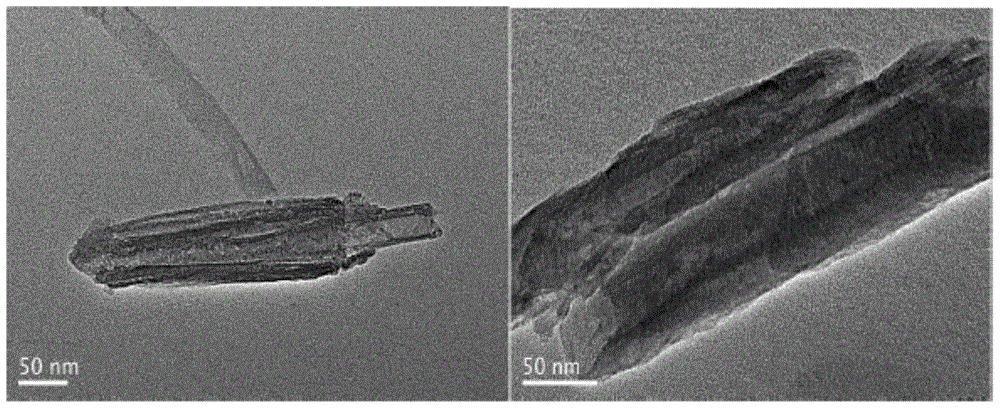Preparation method of tubular carbon nitride
A carbon nitride, tubular technology, applied in nitrogen and non-metallic compounds, nanotechnology for materials and surface science, nanotechnology, etc., can solve the problems of specific surface area decrease, large grain size, small specific surface area, etc., Achieve the effects of controllable shape, large specific surface area and wide application prospects
- Summary
- Abstract
- Description
- Claims
- Application Information
AI Technical Summary
Problems solved by technology
Method used
Image
Examples
Embodiment 1
[0021] 1) Add 100 grams of halloysite clay to 500 grams of hydrochloric acid solution with a hydrogen ion concentration of 0.5 mol / L, and stir and activate it for 1 hour at a temperature of 60° C. to obtain a silicate clay slurry. Add 120 grams of dicyandiamide The amine was added to the above silicate clay slurry, ultrasonically dispersed for 60 minutes: part of the water was evaporated to prepare the halloysite clay composite slurry.
[0022] 2) Transfer the halloysite clay composite slurry obtained in step 1 into a crucible, place it in a tube furnace at a heating rate of 8°C per minute, raise the temperature to 580°C, and keep it warm for 2 hours to obtain halloysite / C 3 N 4 Complex.
[0023] Halloysite / C will then be produced 3 N 4 The complex was added to a 10% hydrogen fluoride solution by mass percentage, allowed to stand for 12 hours, filtered and washed until the filtrate pH = 6, and dried at 80°C for 6 hours to obtain tubular C 3 N 4 .
Embodiment 2
[0025] 1) Add 90 grams of attapulgite clay to 300 grams of sulfuric acid solution with a hydrogen ion concentration of 3 mol / L, stir and activate for 4 hours at a temperature of 85°C to obtain a silicate clay slurry, and add 45 grams of melamine to the The attapulgite clay slurry was ultrasonically dispersed for 30 minutes; then part of the water was evaporated to prepare the attapulgite clay composite slurry.
[0026] 2) Transfer the attapulgite clay composite slurry obtained in step 1 into a crucible, place it in a tube furnace at a heating rate of 0.5°C per minute, raise the temperature to 450°C, and keep it warm for 5 hours to obtain attapulgite / C 3 N 4 Complex.
[0027] Then the prepared attapulgite / C 3 N 4 Add the complex to a 5% hydrogen fluoride solution by mass, let it stand for 24 hours, filter, wash until the filtrate pH=7, and dry at 80°C for 2 hours to obtain tubular C 3 N 4 .
Embodiment 3
[0029] 1) Add 80 grams of sepiolite clay to 200 grams of sulfuric acid mixed solution with a hydrogen ion concentration of 5 mol / L, stir and activate for 3 hours at a temperature of 75°C to obtain a silicate clay slurry, and add 160 grams of urea to the In the above sepiolite clay slurry, ultrasonically disperse for 45 minutes; then evaporate part of the water to prepare sepiolite clay composite slurry.
[0030] 2) Transfer the sepiolite clay composite slurry obtained in step 1 into a crucible, place it in a tube furnace at a heating rate of 15°C per minute, raise the temperature to 550°C, and keep it warm for 7 hours to obtain sepiolite / C 3 N 4 Complex.
[0031] Sepiolite / C will then be prepared 3 N 4 The complex was added to a 20% ammonium bifluoride solution by mass, allowed to stand for 18 hours, filtered and washed until the filtrate pH = 6.5, and vacuum-dried at 80°C for 10 hours to obtain a hollow tubular C 3 N 4 .
PUM
 Login to View More
Login to View More Abstract
Description
Claims
Application Information
 Login to View More
Login to View More - R&D
- Intellectual Property
- Life Sciences
- Materials
- Tech Scout
- Unparalleled Data Quality
- Higher Quality Content
- 60% Fewer Hallucinations
Browse by: Latest US Patents, China's latest patents, Technical Efficacy Thesaurus, Application Domain, Technology Topic, Popular Technical Reports.
© 2025 PatSnap. All rights reserved.Legal|Privacy policy|Modern Slavery Act Transparency Statement|Sitemap|About US| Contact US: help@patsnap.com


